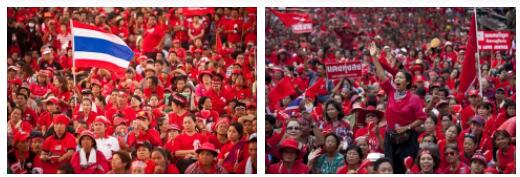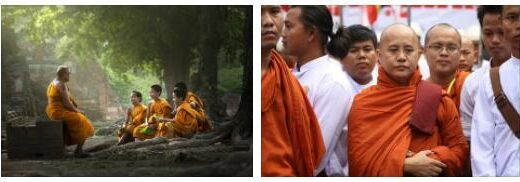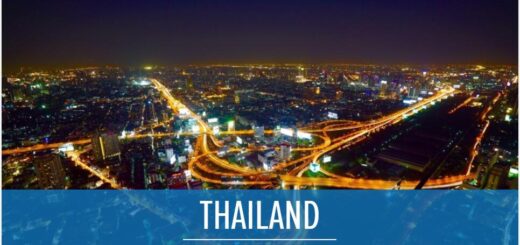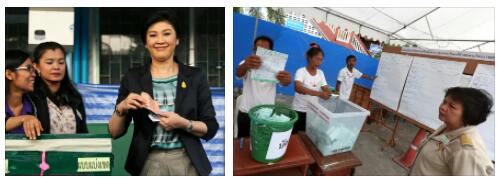Thailand Yellow Shirts and Red Shirts
Domestically, Thailand has been dominated by the political polarization between the yellow shirts and the red shirts since 2005. The background is the (too) successful rise of billionaire Thaksin Shinawatra, who won the 2001 election with his Thai Rak Thai (TRT, “Thais love Thais”) party. As Prime Minister he ran the country – as he himself said – “like a company” – and was able to put the poorer classes behind him with social programs such as the introduction of a general, tax-financed and almost free health system (the “30 baht program”). But the popularity of Thaksin and the wealth of economic, media and political power that he was able to unite, endangered the so-called “royal network”by veterans of the military, high officials and wealthy families around King Bhumibol. At the same time, Thaksin’s “Keynsian turbo-capitalism” polarized society. After he had sold his media empire “Shin Corp” tax-free to the Singaporean state-owned company Temasek, a mass movement emerged in 2005, which Thaksin initiated because of the planned free trade agreement with the USA and his tough policies in the south of the country criticized.
The yellow shirts
This “People’s Alliance for Democracy” (PAD) was led by veterans of the democracy movement from 1992 (Chamlong Srimuang, Somsak Kosaisuk) and media entrepreneur Sondhi Limthongkul, whose supporters began to wear the royal color yellow. Sondhi initiated the 2006 coup politically by calling for “royal intervention”. Even after the coup, the yellow shirts did not accept the later election victories of the Thaksin supporters, and therefore occupied Suvarnabhumi Airport in Bangkok in 2008. The electoral successes of the red shirts prompted the PAD to come up with the so-called “ New Politics”To move away from the principle of an elected parliament. In order to expand their influence over the longer term, the PAD leaders founded the New Politics Party in 2009. Their little success and different positions in the 2011 election led to the split, in which Sondhi called for a boycott and Somsak ran with the party. The election result was a disaster with 0.2% of the vote. The PAD leadership quartet resigned in 2013, which effectively meant the end of the organization.
The red shirts
Your opponents, the so-called ” red shirts,” however vehemently defend the principle “All power comes from the people.” After the coup in 2006, various groups formed the United Front of Democracy against Dictatorship (UDD), which acts as the umbrella organization for coup opponents and Thaksin supporters.The red shirts insist on the right of the majority to democratically elect and reject the prime minister and the government The intervention of the military, the judiciary and the royal network in politics ended. After two other Prime Ministers close to Thaksinn (Samak Sundaravej and Somchai Wongsawat) were legally ousted, the red shirts mobilized in April and May 2010 hundreds of thousands went to Bangkok to demand the resignation of Prime Minister Abhisit Vejjajiva and new elections. The week-long occupation of the business district was forcibly broken up by the military. Around 50 people were shot dead by snipers. Many of the demonstrators went to jail or went into hiding. To date, no one has been held accountable for cracking down on the protests. The red shirts defended “their” government and Yingluck, but were also increasingly critical of them. The planned amnesty law generated a lot of resentment because those responsible for the crackdown on the red shirt protests in 2010 would have remained unmolested. In the face of new protests and judicial interventions against the government, the red shirts became increasingly radicalized and prepared for civil war-like conditions to “defend” democracy. However, they did nothing to counter the 2014 coup and have become increasingly irrelevant as a movement.
Constitution and separation of powers
Until the recent coup, Thailand’s political system was officially a constitutional monarchy with an elected lower house (parliament) and upper house (the senate) that together make up the national assembly. However, due to the political influence of the military, parliament sometimes had more, sometimes less real influence. Thailand’s turbulent history and changeable government formation also led to a large number of constitutions, 19 so far in number. Of crucial importance was the so-called “ Constitution of the People””From 1997, which came about with civil society participation and was seen by many as a step towards a“ democratic constitutional state ”. Others, however, judge the strengthening of the courts stipulated in it as “disempowering parliament” and as part of safeguarding power for the elite. After its coup in 2006, the military regime had a new constitution written that further strengthens the power of the courts and the only half-elected Senate in order to curtail the power of the prime minister (and thus also prevent Thaksin’s return). After Thaksin’s sister Yingluck Shinawatra won the election, a new constitution was drafted worked to give more power back to parliament. The new military junta then dissolved the current constitution and drafted an undemocratic new version with the help of a military-riddled assembly. This transitional constitution of 2014 was written by the military regime itself and gives the National Council for Peace and Order (NPCO) extensive dictatorial powers and immunity for all of its actions. A new constitution was drawn up by the “Constitution Drafting Committee”, whose members were personally selected by the dictator Prayuth and which consists almost exclusively of the military, monarchists and yellow shirts. King Vajiralongkorn has after some changes requested of him, signed the new constitution, which permanently consolidates the power of the military.



